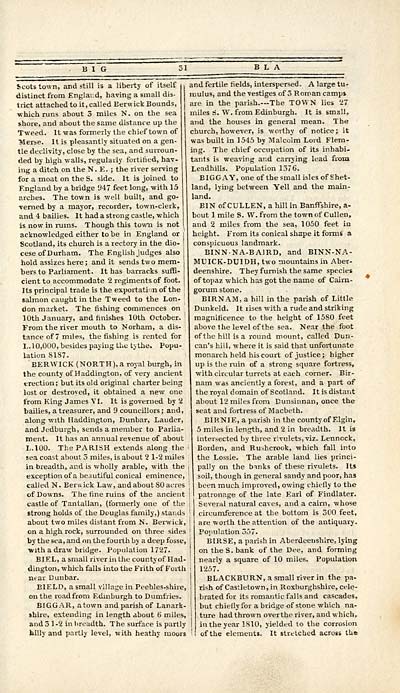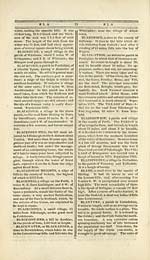Gazetteer of Scotland
(33) Page 31
Download files
Complete book:
Individual page:
Thumbnail gallery: Grid view | List view

51
L A
Scots town, and still is a liberty of itself
distinct from England, having a small dis-
trict attached to it, called Berwick Bounds,
■which runs about 5 miles N. on the sea
shore, and about the same distance up the
Tweed. It was formerly the chief town of
Merse. It is pleasantly situated on a gen-
tle declivity, close by the sea, and surroun-
ded by high walls, regularly fortified, hav-
ing a ditch on the N. E. ; the river serving
for a moat on the S. side. It is joined to
England by a bridge 947 feet long, with 15
arches. The town is -well built, and go-
verned by a mayor, recorder, town-clerk,
and 4 bailies. It had a strong castle, which
is now in rums. Though this town is not
acknowledged either to be in England or
Scotland, its church is a rectory in the dio-
cese of Durham. The English judges also
hold assizes here ; and it sends two mem-
bers to Parliament. It has barracks suffi-
cient to accommodate 2 regiments of foot.
Its principal trade is the exportation of the
salmon caught in the Tweed to the Lon-
don market. The fishing commences on
10th January, and finishes 10th October.
From the river mouth to Norham, a dis-
tance of 7 miles, the fishing is rented for
I.. 1 0,000, besides paying the ty the. Popu-
lation 8187.
BERWICK (NORTH), a royal burgh, in
the county of Haddington, of very ancient
erection ; but its old original charter being
lost or destroyed, it obtained a new one
from King James VI. It is governed by 2
bailies, a treasurer, and 9 councillors ; and,
along with Haddington, Dunbar, Lauder,
and Jedburgh, sends a member to Parlia-
ment. It has an annual revenue of about
L.100. The PARISH extends along the
sea coast about 5 miles, is about 2 1-2 miles
in breadth, and is wholly arable, with the
exception of a beautiful conical eminence,
called N. Berwick Law, and about 80 acres
of Downs. The fine ruins of the ancient
castle of Tantallan, (formerly one of the
strong holds of the Douglas family,) stands
about two miles distant from N. Berwick,
on a high rock, surrounded on three sides
by the sea, and nn the fourth by a deep fosse,
■with a draw bridge. Population 1727.
BIEL, a small river in the county of Had-
dington, which falls into the Frith of Forth
near Dunbar.
BIELD, a small village in Peebles-shire,
on the road from Edinburgh to Dumfries.
BIGGAR, atown and parish of Lanark-
shire, extending in length about 6 miles,
and 3 1-2 in breadth. The surface is partly
billy and partly level, with heathy moors
and fertile fields, interspersed. A large tu-
mulus, and the vestiges of 3 Roman camps
are in the parish.— The TOWN lies 27
miles S. W. from Edinburgh. It is small,
and the houses in general mean. The
church, however, is worthy of notice; it
was built in 1545 by Malcolm Lord Flem-
ing. The chief occupation of its inhabi-
tants is weaving and carrying lead from
Leadhills. Population 1576.
BIGGAY, one of the small isles of Shet-
land, lying between Yell and the main-
land.
BIN of CULLEN, a hill in Banffshire, a-
bout 1 mile S. W. from the town of Cull en,
and 2 miles from the sea, 1050 feet in
height. From its conical shape it forms a
conspicuous landmark.
BINN-NA-BA1RD, and BINN-NA-
MUICK-DUIDH, two mountains in Aber-
deenshire. They furnish the same species
of topaz which has got the name of Cairn-
gorum stone.
BIRNAM, a hill in the parish of Little
Dunkeld. It rises with a rude and striking
magnificence to the height of 1580 feet
above the level of the sea. Near the foot
of the hill is a round mount, called Dun-
can's hill, where it is said that unfortunate
monarch held his court of justice; higher
up is the ruin of a strong square fortress,
with circular turrets at each corner. Bir-
nam was anciently a forest, and a part of
the royal domain of Scotland. It is distant
about 12 miles from Dunsinnan, once the
seat and fortress of Macbeth.
BIRNIE, a parish in the county of Elgin,
5 miles in length, and 2 in breadth. It is
intersected by three rivulets, viz. Lennock,
Borden, and Rushcrook, which fall into
the Lossie. The arable land lies princi-
pally on the banks of these rivulets. Its
soil, though in general sandy and poor, has
been much improved, owing chiefly to the
patronage of the late Earl of Findlater.
Several natural caves, and a cairn, whose
circumference at the bottom is 300 feet,
are worth the attention of the antiquary.
Population 557.
BIRSE, a parish in Aberdeenshire, lying
on the S. bank of the Dee, and forming
nearly a square of 10 miles. Population
1257.
BLACKBURN, a small river in the pa-
rish of Castletown, in Roxburghshire, cele-
brated for its romantic falls and cascades,
but chiefly for a bridge of stone which na-
ture had thrown overthe river, and which,
in the year 1S10, yielded to the corrosion
of the elements. It stretched across the
L A
Scots town, and still is a liberty of itself
distinct from England, having a small dis-
trict attached to it, called Berwick Bounds,
■which runs about 5 miles N. on the sea
shore, and about the same distance up the
Tweed. It was formerly the chief town of
Merse. It is pleasantly situated on a gen-
tle declivity, close by the sea, and surroun-
ded by high walls, regularly fortified, hav-
ing a ditch on the N. E. ; the river serving
for a moat on the S. side. It is joined to
England by a bridge 947 feet long, with 15
arches. The town is -well built, and go-
verned by a mayor, recorder, town-clerk,
and 4 bailies. It had a strong castle, which
is now in rums. Though this town is not
acknowledged either to be in England or
Scotland, its church is a rectory in the dio-
cese of Durham. The English judges also
hold assizes here ; and it sends two mem-
bers to Parliament. It has barracks suffi-
cient to accommodate 2 regiments of foot.
Its principal trade is the exportation of the
salmon caught in the Tweed to the Lon-
don market. The fishing commences on
10th January, and finishes 10th October.
From the river mouth to Norham, a dis-
tance of 7 miles, the fishing is rented for
I.. 1 0,000, besides paying the ty the. Popu-
lation 8187.
BERWICK (NORTH), a royal burgh, in
the county of Haddington, of very ancient
erection ; but its old original charter being
lost or destroyed, it obtained a new one
from King James VI. It is governed by 2
bailies, a treasurer, and 9 councillors ; and,
along with Haddington, Dunbar, Lauder,
and Jedburgh, sends a member to Parlia-
ment. It has an annual revenue of about
L.100. The PARISH extends along the
sea coast about 5 miles, is about 2 1-2 miles
in breadth, and is wholly arable, with the
exception of a beautiful conical eminence,
called N. Berwick Law, and about 80 acres
of Downs. The fine ruins of the ancient
castle of Tantallan, (formerly one of the
strong holds of the Douglas family,) stands
about two miles distant from N. Berwick,
on a high rock, surrounded on three sides
by the sea, and nn the fourth by a deep fosse,
■with a draw bridge. Population 1727.
BIEL, a small river in the county of Had-
dington, which falls into the Frith of Forth
near Dunbar.
BIELD, a small village in Peebles-shire,
on the road from Edinburgh to Dumfries.
BIGGAR, atown and parish of Lanark-
shire, extending in length about 6 miles,
and 3 1-2 in breadth. The surface is partly
billy and partly level, with heathy moors
and fertile fields, interspersed. A large tu-
mulus, and the vestiges of 3 Roman camps
are in the parish.— The TOWN lies 27
miles S. W. from Edinburgh. It is small,
and the houses in general mean. The
church, however, is worthy of notice; it
was built in 1545 by Malcolm Lord Flem-
ing. The chief occupation of its inhabi-
tants is weaving and carrying lead from
Leadhills. Population 1576.
BIGGAY, one of the small isles of Shet-
land, lying between Yell and the main-
land.
BIN of CULLEN, a hill in Banffshire, a-
bout 1 mile S. W. from the town of Cull en,
and 2 miles from the sea, 1050 feet in
height. From its conical shape it forms a
conspicuous landmark.
BINN-NA-BA1RD, and BINN-NA-
MUICK-DUIDH, two mountains in Aber-
deenshire. They furnish the same species
of topaz which has got the name of Cairn-
gorum stone.
BIRNAM, a hill in the parish of Little
Dunkeld. It rises with a rude and striking
magnificence to the height of 1580 feet
above the level of the sea. Near the foot
of the hill is a round mount, called Dun-
can's hill, where it is said that unfortunate
monarch held his court of justice; higher
up is the ruin of a strong square fortress,
with circular turrets at each corner. Bir-
nam was anciently a forest, and a part of
the royal domain of Scotland. It is distant
about 12 miles from Dunsinnan, once the
seat and fortress of Macbeth.
BIRNIE, a parish in the county of Elgin,
5 miles in length, and 2 in breadth. It is
intersected by three rivulets, viz. Lennock,
Borden, and Rushcrook, which fall into
the Lossie. The arable land lies princi-
pally on the banks of these rivulets. Its
soil, though in general sandy and poor, has
been much improved, owing chiefly to the
patronage of the late Earl of Findlater.
Several natural caves, and a cairn, whose
circumference at the bottom is 300 feet,
are worth the attention of the antiquary.
Population 557.
BIRSE, a parish in Aberdeenshire, lying
on the S. bank of the Dee, and forming
nearly a square of 10 miles. Population
1257.
BLACKBURN, a small river in the pa-
rish of Castletown, in Roxburghshire, cele-
brated for its romantic falls and cascades,
but chiefly for a bridge of stone which na-
ture had thrown overthe river, and which,
in the year 1S10, yielded to the corrosion
of the elements. It stretched across the
Set display mode to: Large image | Transcription
Images and transcriptions on this page, including medium image downloads, may be used under the Creative Commons Attribution 4.0 International Licence unless otherwise stated. ![]()
| Gazetteers of Scotland, 1803-1901 > Gazetteer of Scotland > (33) Page 31 |
|---|
| Permanent URL | https://digital.nls.uk/97422090 |
|---|

